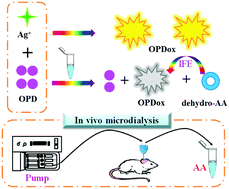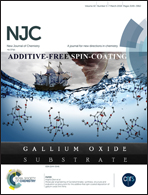Simple and label-free fluorescence detection of ascorbic acid in rat brain microdialysates in the presence of catecholamines†
Abstract
Ascorbic acid (AA), as one of the most important neurochemicals in cerebral systems, plays a vital role in many physiological and pathological processes. Herein, a facile, label-free, and ultrasensitive fluorescence sensing system was developed for the determination of AA based on the Ag+–o-phenylenediamine (OPD) interaction. OPD could be oxidized by Ag+ to generate fluorescent 2,3-diaminophenazine (OPDox). When AA was introduced, on the one hand, AA can inhibit the oxidation process due to its strong reducing capability. On the other hand, AA can be oxidized to dehydro-AA with an absorption peak at 380 nm, which has a good spectral overlap with the emission of OPDox. Thus, the inner filter effect (IFE) between dehydro-AA and OPDox may occur. Therefore, the introduction of AA can intensively suppress the fluorescence of the Ag+–OPD system. Benefitting from the remarkable synergistic effect of the reducing capability of AA and IFE, a facile and ultrasensitive sensor was constructed successfully for AA sensing. The whole detection procedure was achieved within 10 min. The linear response range of AA was obtained from 0.05 to 40 μM with a detection limit of 10 nM. This developed method has many merits including more simplicity, good selectivity, excellent biocompatibility, and more cost-effectiveness without using any nanomaterials. Notably, the proposed method was successfully applied to detect AA in rat brain microdialysates in the presence of catecholamines, thus providing a new route for AA detection in physiological and pathological fields.



 Please wait while we load your content...
Please wait while we load your content...